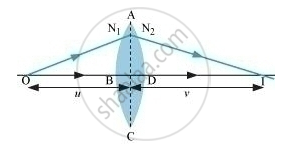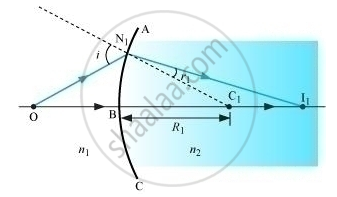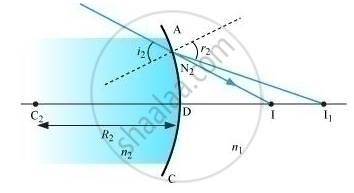Advertisements
Advertisements
Question
Trace the rays of light showing the formation of an image due to a point object placed on the axis of a spherical surface separating the two media of refractive indices n1 and n2. Establish the relation between the distances of the object, the image and the radius of curvature from the central point of the spherical surface.
Hence derive the expression of the lens maker’s formula.
Solution



In the given figure, image is I and object is denoted as O.
The centre of curvature is C.
The rays are incident from a medium of refractive index `n_1`to another of refractive index`n_2`.
We consider NM to be perpendicular to the principal axis.
`tan angleNOM = (MN)/(OM)`
`tan angleNCM = (MN)/(MC)`
`tan angleNIM = (MN)/(MI)`
For ΔNOC, i is the exterior angle.
Therefore, i = ∠NOM + ∠NCM
`i =(MN)/(OM) + (MN)/(MC)`
Similarly,
r = ∠NCM − ∠NIM
i.e., `r = (MN)/(MC) - (MN)/(MI)`
According to Snell’s law,
`n_1 sin i = n_2 sin r`
For small angles,
`n_1i = n_2r`
Substituting i and r, we obtain
`n_1/(OM) + (n_2)/(MI) = (n_2 - n_1)/(MC)`
Where, OM, MI, and MC are the distances
OM = −u
MC = +R
MI = v
Substituting these, we obtain
`n_2/v -n_1/u = (n_2 -n_1)/R .. (1)`
Applying equation (i) to lens ABCD, we obtain for surface ABC,
`n_1 /(OB) +n_2/(BI_1) = (n_2 -n_1)/(BC_1) ... (2)`
For surface ADC, we obtain
`(-n_2)/(DI_1) + (n_1)/(DI) = (n_2n_1)/(DC_2) ..... (3)`
For a thin lens,
BI1 = DI1
Adding (ii) and (iii), we obtain
`n_1/(OB) + n_1/(DI) = (n_2-n_1) [1/(BC_1) +1/(DC_2)]`
Suppose object is at infinity and DI = f, then
`n_1/f = (n_2 - n_1) [1/(BC_1)+1/(DC_2)]`
This is known as lens maker’s formula.
APPEARS IN
RELATED QUESTIONS
In the following diagram, an object 'O' is placed 15 cm in front of a convex lens L1 of focal length 20 cm and the final image is formed at I at a distance of 80 cm from the second lens L2. Find the focal length of the lens L2.

Can a virtual image be photographed by a camera?
If a spherical mirror is dipped in water, does its focal length change?
If a thin lens is dipped in water, does its focal length change?
Four modifications are suggested in the lens formula to include the effect of the thickness t of the lens. Which one is likely to be correct?
A screen is placed 80 cm from an object. The image of the object on the screen is formed by a convex lens placed between them at two different locations separated by a distance 20 cm. determine the focal length of the lens.
Thin lens approximation for a lens is ______.
| A student is performing an experiment to determine focal length of a convex lens by using lens formula i.e., by no parallax method. The examiner gives some instructions to the student. The student responds to each instruction as per her understanding of the experiment. |
State whether the student's response is correct or incorrect. Give a reason for your answer.
- EXAMINER: Image formed by the lens is magnified. Reduce the size of the image.
STUDENT moves the lens towards the object pin. -
EXAMINER: Plot a graph of (1/v) against (1/u).
STUDENT takes (1/v) on Y axis and (1/u) on X axis. -
EXAMINER: Write the relation between the optical power (P) and the focal length (f) of the convex lens.
STUDENT writes P = 2f.
